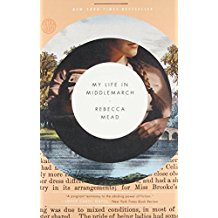My Life in Middlemarch, Rebecca Mead, 2014
An uneven but ultimately very enjoyable introspective account of one author’s deep interest and caring for another, in this case Mead, a New Yorker journalist and George Eliot, nee Mary Ann Evans or Marian Evans, the author of Middlemarch. Mead weaves together three parallel narratives—the plot of Middlemarch (written in 1872), a book which she first read as an adolescent in the Midlands of England and has returned to regularly since, the life of George Eliot (b. 1819-d.1880), and her own life. Occasionally slow and dragging with detail, the book finds its rhythm and soul about half way through, or perhaps it’s just that Eliot’s life becomes more interesting as she gets older. She is revealed as a deeply feeling, independent, very smart and sympathetic soul who found her own ethics and morality after leaving the Church as a young woman and whose writings reflect those deep desires for a sympathetic and compassionate view of other, struggling human beings. Eliot’s unconventional marriage to George Henry Lewes and his four sons is lovingly treated though her marriage to John Walter Cross, 20 years her junior, only 7 months before she died is less kindly treated. Mead weaves back and forth from Dorothea Brooke, Casaubon, Lydgate, Rosamund, Will Ladislow, Mary Garth, Fred Vincy and the others in Middlemarch to Eliot’s own life, finding the major theme of long, calm and loving marriage to emerge. Mead’s own life is, however, not drawn with any detail and leaves the reader wishing to know more. The quotes and scenes from Middlemarch were quite wonderful and I was amazed at the detail with which I recalled this book, read while we were in England several years ago. Mead describes it as a ‘home epic’ in which an encompassing empathy for ourselves and others emerges strengthening Eliot’s meliorist faith where Eliot extols the “abiding love amid the life of the everyday.” The final line of Middlemarch, well recalled by me is the topic of the final chapter as follows: “But the effect of her being on those around her was incalculably diffusive: for the growing good of the world is partly dependent on unhistoric acts; and that things are not so ill with you and me as they might have been, is half owing to the number who lived faithfully a hidden life, and rest in unvisited tombs.” Wonderful job by Eliot and by Mead! In another example of ‘connection’, the NYT Sunday Book Review featured this book on the cover on 1/26/14 in a review by Joyce Carol Oates which referred to it as a bibliomemoir, “a subspecies of literature combining criticism and biography with the intimate, confessional tone of autobiography.” Citing other examples, Oates mentions two of my own Top 10 from 2013, Nicholson Baker’s U&I and Geoff Dyer’s Out of Sheer Rage as well as Christopher Beha’s The Whole Five Feet, another book I read several years ago and David Denby’s Great Books, which sits on my shelf in Brownsville. Oates describes Mead’s book thus: “…a beguilingly straightforward, resolutely orthodox and unshowy account” and recommends it as an “exemplary introduction to the work of George Eliot and a helpful and informed companion guide to Middlemarch.”



